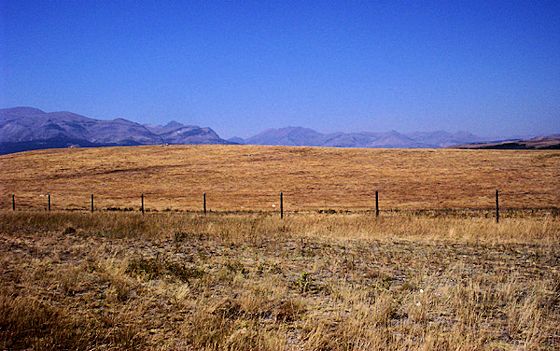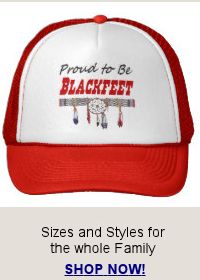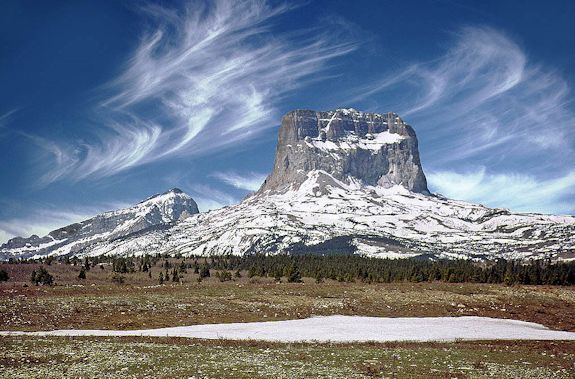Blackfeet Indian Reservation is in the U.S. state of Montana, located just east of Glacier National Park. In fact, the Blackfeet ceded the land that is now Glacier Park to the United States to make the park. It borders the Canadian province of Alberta. The Blackfeet Indian Reservation is home to the primarily Piegan Blackfeet branch, and some Southern Siksika. The other three branches of the Blackfoot tribe reside on other reservations in Alberta, Canada.

Blackfeet Indian Reservation fields, Photo by Rmhermen via Wikimedia Commons
By the time the Blackfeet had migrated to the Northwest, they were organized as a confederacy of three politically independent tribes. The southernmost tribe was the Piegan, the central tribe the Bloods and the northern tribe the Northern Blackfeet or Blackfeet proper.
More specific tribal names for the three groups are: Pikuni – Piegan; Siksika – Northern Blackfeet; and Kainah – Blood. The Kainah and the Siksika reside on reservations in Alberta, Canada.
 The Piegan or Pikuni live on the Blackfeet Reservation in Montana. For consistency and familiarity, this document will use the term “Blackfeet” to refer to the Piegan or Pikuni people who reside on the reservation on the US side of the US-Canadian border.
The Piegan or Pikuni live on the Blackfeet Reservation in Montana. For consistency and familiarity, this document will use the term “Blackfeet” to refer to the Piegan or Pikuni people who reside on the reservation on the US side of the US-Canadian border.
The 2010 census reported a population of 10,405 living on this 3,000 square miles (7,800 km2) reservation. The population density is 3.47 people per square mile (1.34 people/km²).
The main community is Browning, which is the seat of tribal government and home to the Museum of the Plains Indian. Other towns serving the tourist economy along the edge of Glacier Park are St. Mary and East Glacier Park Village, which has an Amtrak station and the historic Glacier Park Lodge. Small communities include Babb, Kiowa, Blackfoot, Seville, Heart Butte, Starr School, and Glacier Homes.
The tribe’s main celebration open to the public is the North American Indian Days pow wow held the weekend after the 4th of July each year.
Topography of the Reservation
Chief Mountain is sacred to the Blackfeet. The mountain marks the boundary between the Blackfeeett Reservation in Montana and Glacier National Park.
Photo Credit: www.rodjonesphotography.co.uk, CC BY-SA 3.0, via Wikimedia Commons
The eastern part of the reservation is mostly open hills of grassland, while a narrow strip along the western edge is covered by forests of fir and spruce. Chief Mountain is sacred to the Blackfeet. Free-ranging cattle are present in several areas.
Several waterways drain the area with the largest being the St. Mary River, Two Medicine River, Milk River, Birch Creek and Cut Bank Creek. There are 175 miles (282 km) of streams and eight major lakes on the reservation.
Reservation Economy
In 2001, the BIA reported 69% unemployment among the 16, 500 registered members of the tribe. Of those employed, 26% earned less than the federal poverty level.
A total of 354 farms cover 1,291,180 acres (5,225.2 km2), the majority of the reservation’s land. Most of these farms are family-owned, including 198 farms which are owned by Native Americans. Eighty percent of the land is used for raising beef cattle, which also produce eighty percent of farm income. Other livestock includes hogs and chickens, with only small numbers of dairy cattle, bison, horses, and sheep.
The Blackfeet have a small foundation herd of Blackfeet Buffalo Horses, which are a breed developed by the Blackfeet from descendants of the Spanish Mustangs.
Of the 245,530 acres (993.6 km2) used for growing crops, only 32,158 acres (130.14 km2), or 13%, were irrigated. Crops raised included wheat, barley, and hay with a smaller amount of oats.
Wildfire firefighting is a major seasonal income source. In 2000, some 1,000 Blackfeet worked as firefighters, including the elite Chief Mountain Hotshots team. Firefighting income brought in $6.1 million that year. However, this income is highly variable depending on the severity of the wildfire season.
These firefighters fight seasonal forest fires all over the United States. They were also among the volunteers who searched for and recovered parts of the Columbia Space Shuttle.
The major income source of the reservation is oil and natural gas leases on the oil fields on tribal lands. In 1982, there were 643 producing oil wells and 47 producing gas wells. The reservation also has a significant tourist industry.
Other economic activities include ranching and a small lumber industry, which supported the Blackfeet Indian Writing Company pencil factory in Browning.
Notable People from the Blackfeet Reservation
- Gordon Belcourt (1945-2013), Former Executive Director of the Montana-Wyoming Tribal Leaders Council
- Elouise P. Cobell, Former tribal treasurer and founder of Blackfeet Nation Bank. Elouise Cobell, also started the class action lawsuit that eventually settled after more than 10 years in the courts for recovering over a billion dollars for the tribes who have been largely cheated of their leasing revenues over the last 200 years, was from Browning.
- Donna Hutchinson, member of the Arkansas House of Representatives from Bella Vista, Arkansas, service from 2007 to 2013
- Earl Old Person, Tribal Chief and political leader
- Steve Reevis (b. August 14, 1962), actor (Geronimo: An American Legend, The Missing)
- Misty Upham (1982-2014), actor
- Black Lodge Singers, traditional music and drum group